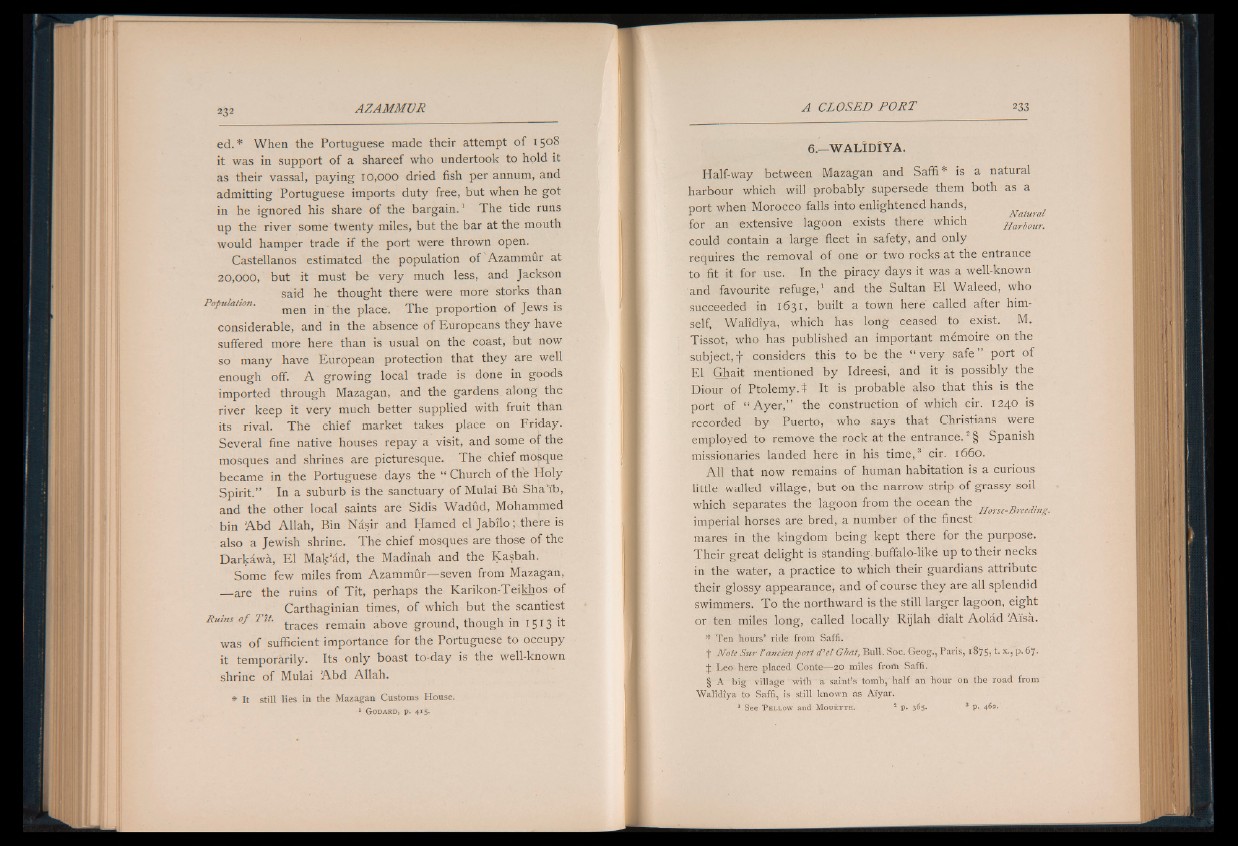
ed. * When the Portuguese made their attempt of 1 5°8
it was in support of a shareef who undertook to hold it
as their vassal, paying 10,000 dried fish per annum, and
admitting Portuguese imports duty free, but when he got
in he ignored his share of the bargain.1 The tide runs
up the river some twenty miles, but the bar at the mouth
would hamper trade if the port were thrown open.
Castellanos estimated the population of Azammur at
20,000, but it must be very much less, and Jackson
said he thought there were more storks than
Population. men ¡n the place. The proportion of Jews is
considerable, and in the absence of Europeans they have
suffered more here than is usual on the coast, but now
so many have European protection that they are well
enough off. A growing local trade is done in goods
imported through Mazagan, and the gardens along the
river keep it very much better supplied with fruit than
its rival. The chief market takes place on Friday.
Several fine native houses repay a visit, and some of the
mosques and shrines are picturesque. The chief mosque
became in the Portuguese days the “ Church of the Holy
Spirit.” In a suburb is the sanctuary of Mulai Bu Sha'i'b,
and the other local saints are Sidis Wadud, Mohammed
bin A b d Allah, Bin Nasir and Hamed el Jabilo; there is
also a Jewish shrine. The chief mosques are those of the
Darkawa, El Mak’ad, the Madinah and the Kasbah.
Some few miles from Azammur— seven from Mazagan,
— are the ruins of Tit, perhaps the Karikon-Teikhos of
Carthaginian times, of which but the scantiest
Ruins o f T it. £r a c e s remajn above ground, though in 15 13 't
was o f sufficient importance for the Portuguese to occupy
it temporarily. Its only boast to-day is the well-known
shrine of Mulai A b d Allah.
* It still lies in the Mazagan Customs House.
1 G o d a r d , p. 415.
6 —WALÎDÎYA.
Half-way between Mazagan and Saffi * is a natural
harbour which will probably supersede them both as a
port when Morocco falls into enlightened hands, raturai
for an extensive lagoon exists there which Harbour.
could contain a large fleet in safety, and only
requires the removal of one or two rocks at the entrance
to fit it for use. In the piracy days it was a well-known
and favourite refuge,1 and the Sultan El Waleed, who
succeeded in 1631, built a town here called after himself,
Walîdîya, which has long ceased to exist. M.
Tissot, who has published an important mémoire on the
subject,! considers this to be the “ very safe” port of
El Ghait mentioned by Idreesi, and it is possibly the
Diour of Ptolemy. X It is probable also that this is the
port of “ Ayer,” the construction of which cir. 1240 is
recorded by Puerto, who says that Christians were
employed to remove the rock at the entrance.2 § Spanish
missionaries landed here in his time,s cir. 1660.
All that now remains of human habitation is a curious
little walled village, but on the narrow strip of grassy soil
which separates the lagoon from the ocean the Horsc_Breeding_
imperial horses are bred, a number of the finest
mares in the kingdom being kept there for the purpose.
Their great delight is standing, buffalo-like up to their necks
in the water, a practice to which their guardians attribute
their glossy appearance, and of course they are all splendid
swimmers. To the northward is the still larger lagoon, eight
or ten miles long, called locally Rijlah dîalt Aolad Aïsa.
* Ten hours’ ride from Saffi.
f Note Sur V ancien port d 'e l Ghat, Bull. Soc. Geog., Paris, 1875? x., p. 67*
J Leo here placed Conte— 20 miles from Saffi.
§ A big village with a saint’s tomb,* half an hour on the road from
Walîdîya to Saffi, is still known as Aïyar.
1 See P e l l o w a n d M o u e t t e . 2 p. 365. 3 p. 462.